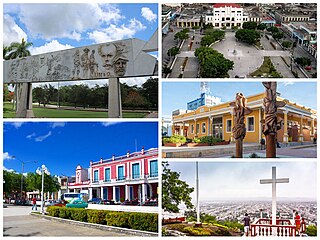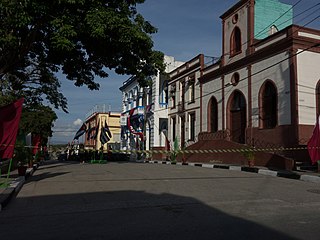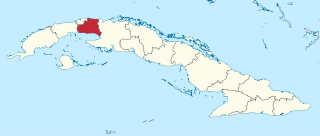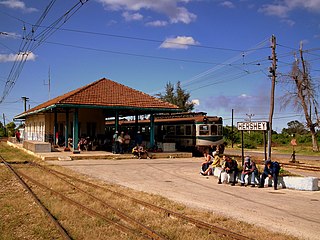
Guantánamo is a municipality and city in southeast Cuba and capital of Guantánamo Province.

Holguín is a municipality-city in Cuba. After Havana, Santiago de Cuba, and Camagüey, it is the fourth largest city in Cuba.

Municipalities of Venezuela are subdivisions of the States of Venezuela. There are 335 municipalities dividing the 23 states and the Capital District.

Palma Soriano is a Cuban city and municipality in the Santiago de Cuba Province. With a population of 119,740 in the city proper, it is the second-largest in the province and the 16th-largest in Cuba.

Jibacoa, or more properly Playa Jibacoa, is a fishing village in the Mayabeque Province of Cuba. It is located in the municipality of Santa Cruz del Norte, at the mouth of the Jibacoa River, 60 km east of Havana.

Bacunayagua is a Cuban village and consejo popular of the municipality of Santa Cruz del Norte, in Mayabeque Province. In 2011 it had a population of 3,371.

San José de las Lajas is a municipality and the capital city of the newly formed Mayabeque Province of Cuba, after the segmentation of La Habana Province in 2011. It is located in the center north of the province, and is bisected by the Carretera Central.
Tlatlaya is one of 125 municipalities of the State of Mexico in Mexico. The municipal seat is the town of Tlatlaya which is the eleventh largest town in the municipality. The word “Tlatlaya” means when the hearth is black and red.

Mayabeque River is a river of western Cuba, considered the largest in the southwestern watershed of Cuba, with an extensive fluvial network that encompasses the municipalities of Güines, San Jose de las Lajas, Jaruco, Madruga, and Melena del Sur. The old outlet in Melena del Sur is named Antiguo Mayabeque. The Antiguo (ancient) Mayabeque is still navigable by small boats in the last 5 km (3.1 mi).
Punto guajiro or punto cubano – or simply punto – is a sung genre of Cuban music, a poetic art with music. It became popular in the western and central regions of Cuba in the 17th century, and consolidated as a genre in the 18th century. It has Andalusian and Canary Islands origins, and it integrated African elements in Cuba.

Mayabeque Province is one of two new provinces created from the former La Habana Province, whose creation was approved by the Cuban National Assembly on August 1, 2010, the other being Artemisa Province. The new provinces came in to existence on January 1, 2011.
Jose D. "Lolo" Villalobos y Olivera was a Cuban politician.

The Hershey Electric Railway, also known as the Hershey Railway, is a standard-gauge electric interurban railway that runs from Casablanca, Havana, to the city of Matanzas, approximately 92 kilometres (57 mi) to the east. There are a number of intermediate halts and a station and depot at the town of Camilo Cienfuegos, better known by its pre-revolutionary name of Hershey. The railway is the only surviving electric line in Cuba. The railway was built by The Hershey Company to transport sugar to the port of Havana. The original electric interurban cars were bought from the JG Brill Company, but these were replaced by 60-year old cars from the Ferrocarrils de la Generalitat de Catalunya in the 1990s.

Hershey is a Cuban village and consejo popular of the municipality of Santa Cruz del Norte, in Mayabeque Province.













